Scent and Subversion (8 page)
Read Scent and Subversion Online
Authors: Barbara Herman

Perfumer:
André Fraysse
Scandal may start off too sweet for some tastes, like a Choward’s violet candy. But once the flowers dissipate, what remains is a cozy (if unscandalous) scent of faintly sweet leather and tobacco. Of course, I think we can understand why it must have seemed scandalous to have an elegant,
perfumed lady smell like she’d just smoked a pack of cigarettes (at the time, still seen as déclassé) and fallen asleep in the leather interior of a car the night before!
Top notes:
Neroli, bergamot, lemon, mandarin, clary sage
Heart notes:
Leather, orris, rose, ylang-ylang
Base notes:
Olibanum, civet, oakmoss, vanilla, vetiver, benzoin
by Weil (1933)
Secret of Venus, Weil’s perfume for women (rather than for furs, like Zibeline and Chinchilla Royal), opens with symphonic herbaceousness, moves into a spicy floral heart, and rests on a velvety, honeyed Oriental base. Its drydown is an irresistible mix of sweet balsams, incense/spice, and an almond-oil facet from tonka. A little like Le Numéro Cinq and Coty’s Styx in style and personality, if a bit sweeter.
The first time I took a whiff, Secret of Venus did that animalic/raunchy lurch that tends to mean that civet is prowling around, but it could just be a really animalic musk. It’s ironic that a perfume in a line meant to hide the smell of the animal in fur can’t resist throwing some animal back
into
the perfume.
Top notes:
Aldehydes, bergamot, lemon, coriander, tarragon
Heart notes:
Rose, jasmine, lily of the valley, ylang-ylang, orris, gardenia
Base notes:
Vetiver, civet, sandal, amber, musk, honey, tonka
by Guerlain (1933)
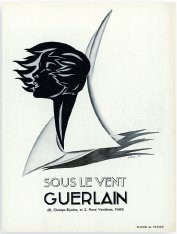
A sculptural face in profile sets sail in artist Darcy’s 1930s-era illustrated interpretation of Guerlain’s Sous le Vent, which literally means “Under the Wind.”
Perfumer:
Jacques Guerlain
A forbiddingly beautiful chypre, Sous le Vent (“Under the Wind”) has the depth and sumptuousness of an ornate Oriental tapestry, with threads of gold and pastel satin panels set against a black velvet backdrop.
Initially, it appears to be a friendly chypre with a lavender-bergamot top shot through with
lovely amber-vanilla. But like smoothing down velvet to watch it change color from light to dark, I notice as I reapply and resniff Sous le Vent that its complexity comes through with spicy, powdery carnation and the inimitable Guerlain vanilla touched with amber.
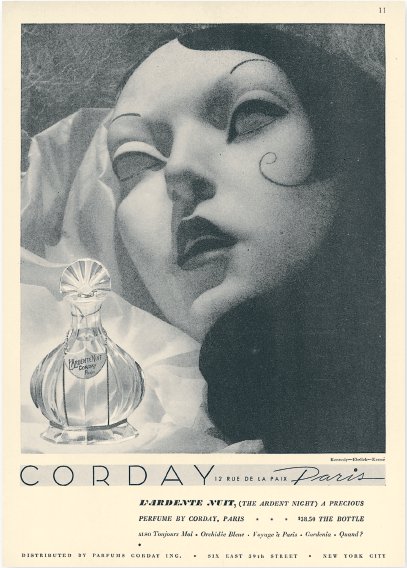
Masks are signature images in Corday perfume ads, but they’re usually depicted as festive or beautiful. This one, from 1936, almost looks like a death mask or something from a horror film. Beautiful, but scary.
I get an almost zesty-green top married to rich florals, with Guerlain’s rich base throwing its magic scrim over all the notes, softening them with its moondust. Sous le Vent is said to have been created for Josephine Baker, the American performer who electrified 1930s Paris in shows at the City of Light’s famed Folies Bergère theater.
Top notes:
Basil, bergamot, lavender, tarragon
Heart notes:
Carnation
Base notes:
Oakmoss, iris, woods, patchouli
(Notes from Victoria Frovola’s perfume blog Bois de Jasmin.)
by Guerlain (1933)
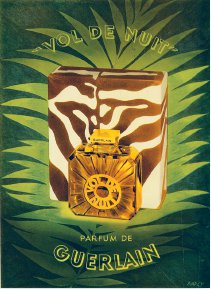
An ad (c. 1943) for Guerlain’s Vol de Nuit
Perfumer:
Jacques Guerlain
Named after the Antoine de Saint-Exupéry novel about night pilots in the early days of aviation, Vol de Nuit (“Night Flight”), the scent, translates the mystery, danger, and poetry of night flying into perfume notes.
Vol de Nuit’s balance of disparate notes is part of its mystery: It starts off green, citrusy, and dry; moves toward a subtle floral heart; and evolves into an orris/vanilla and amber drydown with a mossy finish.
The perfume’s surprise, and what pulls everything together, is its heart of tentative sweetness, from a facet of the narcissus and a subdued jasmine combined with amber and vanilla. It’s as if the dark night sky (the coldness of galbanum and citrus?) suddenly revealed
a twinkling star, and the loneliness and danger of flying turns into an existential adventure, exhilarating instead of treacherous. The moss and resins help to maintain the perfume’s austerity and gravity, but it’s that moment of warmth that creates Vol de Nuit’s emotional center.
Notes not available.
by Coty (1934)
Perfumer:
Vincent Roubert
Nodding its hat to the exoticism and Orientalism of the time, A’Suma has the familiar bergamot, lavender, vanilla, and civet impression of Jicky, Shalimar, and Emeraude. Like Lucien Lelong’s Sirocco, A’Suma, with its haunting addition of incense, adds a flinty, austere character to this otherwise sumptuous perfume, like the smell of a lit match. In advertisements of the time, A’Suma is described as “opulent,” “as exotic as a moonlit beach in Bali,” and with the “sensuous allure of a siren’s song.” I can’t disagree with that.
Notes not available.
by Weil (1934)
A woody Oriental perfume with a beautiful lavender opening and rich, balsamic drydown, Bambou is akin to Tabu and Youth Dew, without much sweetness. Perhaps due to the age of my sample, Bambou feels like it’s almost all base notes, with an almost cocoa-coffee facet that gives it an earthy quality. The reformulation is its polar opposite: fruity and light.
Notes from
ThePerfumedCourt.com:
Lavender, jasmine, rose, carnation, lily of the valley, cedar, tonka, musk, sandal
by Elizabeth Arden (1934)
Perfumer:
George Fuchs
Lavender and neroli join hands at the beginning of Blue Grass to do a little dance together, lavender’s herbaceousness balancing out neroli’s sweetness, both of them announcing summer. Its intense, sweet florals may be too much for some, but Blue Grass balances its fresh top notes with its woody and balsamic base, interpreting summer as ripeness rather than as freshness. I read somewhere that Elizabeth Arden used to
spray her horses with Blue Grass! I bet the smell of this on stinky horsehair would have been amazing.
Top notes:
Aldehydes, lavender, bergamot, neroli, orange
Heart notes:
Jasmine, carnation, narcissus, rose, tuberose
Base notes:
Sandalwood, benzoin, tonka, tonquin musk
by Caron (1934)
Perfumer:
Ernest Daltroff
With a prominent powdery and sweet floral opening characteristic of this era, Fleurs de Rocaille is nevertheless greened with narcissus, spiced with carnation, and eroticized with Ernest Daltroff’s
je ne sais quoi
brand of sexy fairy dust. This happy floral has just enough spice and bite to keep it modern.
Top notes:
Palisander (Brazilian rosewood), bergamot, gardenia, violet
Heart notes:
Jasmine, narcissus, rose, carnation, lily of the valley, ylang-ylang, lilac, mimosa
Base notes:
Amber, sandalwood, musk, cedar
by Lubin (1934)
In Nuit de Longchamp, sweet lilac and moody violet combine with woods, moss, and a nitromusk-rich base to create a perfume that feels paradoxically innocent and erotic. Nitromusks, and perhaps tonka, contribute to a sweet/vanillic/cinnamon heliotrope-like fattiness in the base that provides such a wonderful counterpoint to the delicate lilac note that floats above Nuit de Longchamp’s base of dark woods like an iridescent butterfly in a forest.
Notes from
1982 Dictionnaire des Parfums de France:
Lilac, jasmine, oakmoss, violet, musk, chypre base
by Lanvin (1934)
Perfumer:
André Fraysse
A gourmand leather and tobacco fragrance so beautiful it belongs to a rare scent category for me: perfume so good I want to drink it. Dark vanilla and creamy white florals voluptuously bloom as leather, tobacco, and civet rise up. Peach and plum add some bruised sweetness.
When I visualize Rumeur, I imagine those dark, fleshy, oddly colored orchids that you can hardly believe are flowers. My Sin and Baghari are white and sensual flowers—Rumeur their darker cousin. Its addition of costus, the perfume note that smells a bit like sebum/bed-head, takes Rumeur’s uncanny, singular sexiness to another level. It’s in my top five favorite vintage perfumes of all time.
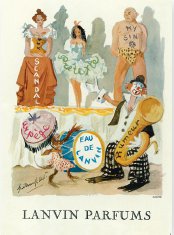
In this fanciful 1956 ad by artist Al Janvic, who illustrated a whole series of perfume ads for Lanvin featuring street scenes, Lanvin perfumes are individually represented by circus figures.
The
1964 Dictionnaire des Parfums de France
describes Rumeur as “a spicy fragrance featuring cyclamen, gardenia, vetiver, patchouli, violet leaves and amber. It evokes a fragrant forest, orchards under the sun, and oriental flowers … It is an evening perfume that will mostly appeal to brunettes.” According to perfume historian Octavian Coifan, Rumeur is a fruity chypre between Mitsouko and Femme.
Notes from
Octavian Coifan:
Peach, plum, dark vanilla, nutmeg, cardamom, clove, civet, costus, tobacco, and Cuir de Russie (“Russia Leather”) bases prepared by Synarome
by Lucien Lelong (1934)
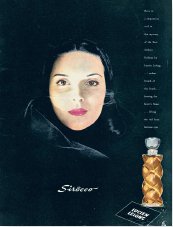
“Here in a serpentine vial is the mystery of the East,” reads the copy on this 1943 advertisement for Lucien Lelong’s Orientalist fantasy in a bottle.
Sirocco
is the name for the desert wind that blows from North Africa to Europe.